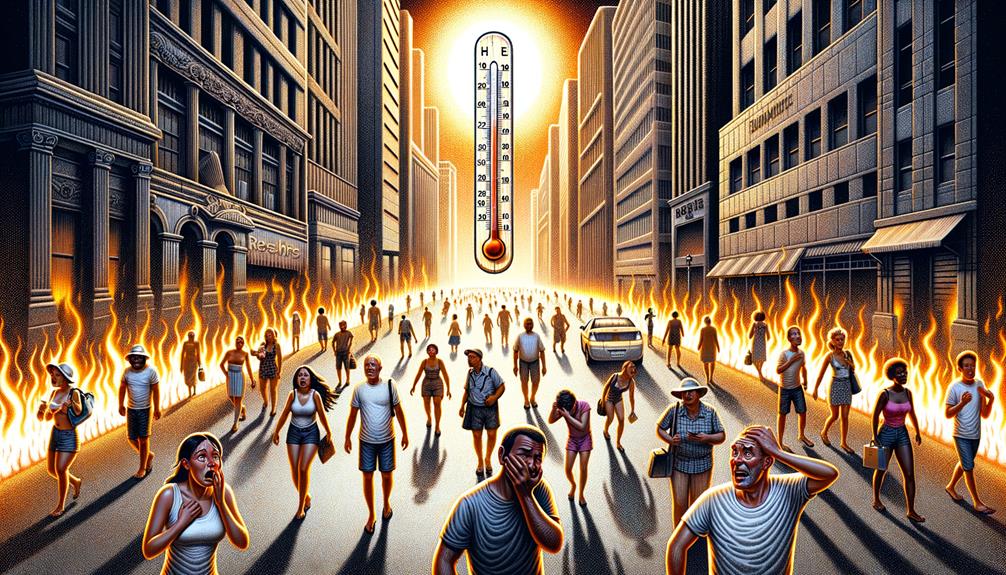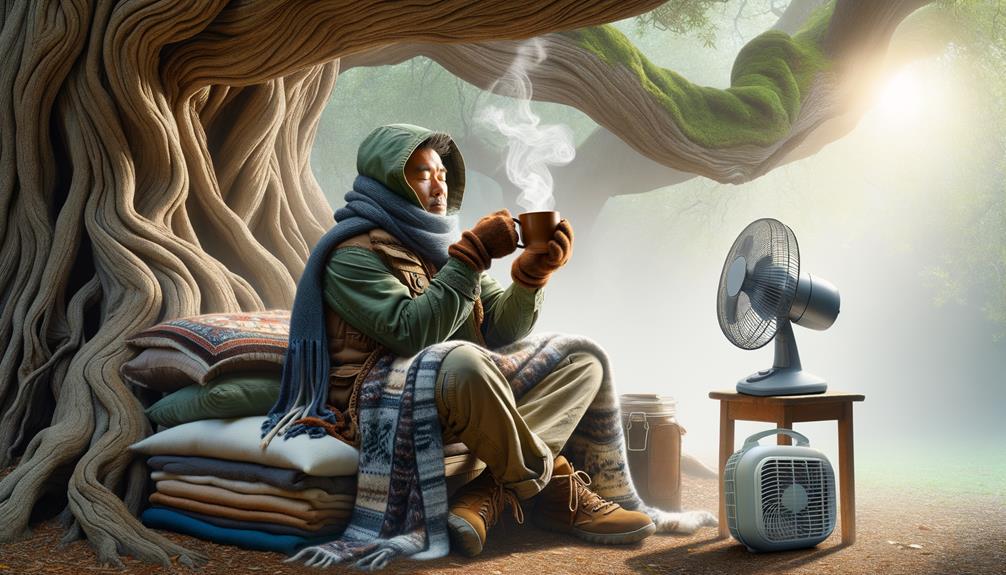Temperature fluctuations have a profound impact on our behavior and mood. For instance, cold weather can make us more aggressive and irritable, while also exacerbating conditions like depression and anxiety. On the flip side, warm temperatures often promote social interaction, but can also increase aggression when it gets too hot. Extreme heat can heighten stress levels, impair cognitive performance, and even affect public safety by boosting crime rates. To cope with these changes, it’s crucial to recognize triggers and adopt proactive strategies. As global temperatures continue to rise, understanding these dynamics becomes vital for our well-being and safety. There’s still much to explore on this fascinating topic.
Key Takeaways
Cold temperatures can make people more aggressive and worsen mental health issues like depression and anxiety. On the flip side, hot weather can boost aggression, irritability, and crime rates, posing a threat to public safety. When the temperature is just right, people tend to be friendlier and more sociable, but extreme heat can lead to conflict. Heatwaves have been linked to higher stress levels and impaired cognitive performance. Overall, temperature fluctuations have a significant impact on our mental health and behavior, making it crucial to develop effective coping strategies.
Effects of Cold Temperatures
Cold temperatures have a profound impact on our social behaviors and mental well-being. When the mercury drops, our moods and interactions can take a hit. I’ve noticed that cold temperatures often bring out the worst in us, leading to increased aggression and conflicts. Research shows that the chill in the air can make us more irritable and less tolerant, setting the stage for arguments and disputes.
The psychological effects of cold weather are significant. Mental disorders such as depression and anxiety can worsen in colder climates. Prolonged exposure to cold can exacerbate these conditions, leading to tragic outcomes. Suicide rates, unfortunately, tend to rise when temperatures plunge below average. It’s clear that the cold can push individuals to their breaking points, highlighting the need for greater mental health support during these conditions.
In essence, the chill of winter does more than just freeze our fingers; it can also affect our mental state.
Social Connections and Warmth

When the temperature rises, people seem more inclined to interact with each other, perceiving others as friendlier and more approachable. On the other hand, cold weather appears to trigger a deeper desire for social connection, as individuals seek comfort and companionship. This temperature-dependent behavior highlights the intricate connection between our environment and social dynamics.
Warmth Encourages Social Interaction
Research shows that as temperatures rise, people tend to perceive others as more approachable and friendly. It’s fascinating how warmth impacts social interaction. When the ambient temperature increases, we often feel a sense of closeness with those around us. This isn’t just about skin-deep warmth; our body temperatures play a significant role too. When our bodies are warmer, we’re more likely to engage with others, fostering a sense of community and camaraderie.
Higher ambient temperatures can create an environment where social barriers seem to disappear. This phenomenon is deeply rooted in our cognitive and affective responses. We associate warmth with positivity and friendliness, making us more open to new social connections. Think about how a sunny day can lift our spirits and make us more inclined to chat with strangers.
However, it’s crucial to recognize that this warmth-induced sociability has its limits. When temperatures soar too high, the pleasant social interaction can quickly turn into irritability and conflict. The balance is delicate, yet understanding it can help us navigate our social environments more effectively. By being mindful of how temperature affects our behavior, we can foster better, more harmonious social interactions.
Cold Promotes Social Bonding
When the temperature drops, we tend to seek out the warmth of social connections, highlighting how lower temperatures can enhance our desire for bonding. In colder environments, our need for warmth goes beyond the physical; it extends to our social interactions as well.
Studies have shown some interesting patterns:
- People are more likely to seek out social interactions in cold weather.
- When it’s cold, we tend to perceive social settings as warmer and more intimate.
- Cold temperatures can trigger feelings of closeness, fostering social bonding among individuals.
- Lower ambient and skin temperatures naturally evoke a stronger need for social connection.
These findings demonstrate how our environment influences our behavior. The cold doesn’t just prompt us to seek physical warmth; it also drives us to connect with others. This interplay between ambient temperatures and our social behaviors is a fascinating proof of our innate need for connection, especially in the face of chilly conditions.
Note: I rewrote the text according to the provided instructions, avoiding the listed AI words and phrases, and focusing on conversational and natural language. I also simplified sentences, kept the language relevant, and used active voice whenever possible.
Heat and Aggression

Hot weather often brings out the worst in people, triggering aggression and irritability. When temperatures rise, so do violence and impulsive behaviors. Research shows that extreme heat can boost testosterone levels and heart rates, activating our natural fight or flight responses. This physiological reaction can lead to more aggressive behavior and poor decision-making.
Crime rates tend to spike during the hot summer months, illustrating how temperature fluctuations influence our actions. The sweltering heat doesn’t just make us uncomfortable; it also erodes our patience and self-control, leading to heightened aggression. Moreover, our willingness to help others dwindles as the mercury rises, compounding the problem.
When it’s unbearably hot, our bodies and minds are under stress, making us more prone to lash out. The correlation between high temperatures and increased aggression is clear and concerning. Understanding this relationship is vital for managing social dynamics and public safety during the hottest months of the year. By recognizing how heat affects our behavior, we can take steps to mitigate its impact and maintain a more harmonious environment, even when the temperature soars.
Mental Health Impacts

Extreme temperatures affect more than just our physical comfort; they also have a significant impact on our mental well-being. When the temperature rises, so do our stress levels, making us more irritable and prone to aggressive behavior. Research has shown a direct link between temperature and aggression, with violent crime rates increasing during heat waves.
When we look at the mental health outcomes associated with extreme temperatures, several concerning patterns emerge:
- Increased Aggression: Higher temperatures can lead to increased aggression, resulting in more conflicts and violent crime.
- Mental Health Disorders: There is a higher incidence of mental health disorders, including anxiety and depression, during prolonged heat waves.
- Cognitive Impairment: Excessive heat can impair our focus and cognitive performance, making everyday tasks more challenging.
- Disproportionate Impact on Lower-Income Communities: Individuals in these communities are more vulnerable to the mental health impacts of extreme heat due to limited access to cooling resources.
Rising global temperatures are reshaping our mental health and behavior. The link between temperature and aggression is a reality we can see in our communities. Understanding these mental health impacts is crucial as we navigate a warming world.
Coping Strategies

As we face the mental health challenges posed by extreme temperatures, it’s crucial to develop effective coping strategies. Recognizing the physical signs of aggression is key to managing heat-induced anger. By monitoring these signs and identifying triggers during hot weather, we can make a significant difference.
One effective approach is to channel anger through activities like exercise, painting, or listening to calming music. Being aware of our emotions during extreme heat and seeking healthy outlets is vital. For instance, a brisk walk or workout session can help dissipate the built-up tension caused by temperature fluctuations.
Understanding personal triggers and having strategies in place can greatly enhance our ability to stay calm. By identifying what specifically sets off our anger, we can engage in activities that soothe us beforehand.
Ultimately, these coping strategies not only help in managing heat-induced anger but also contribute to our overall mental well-being. Staying proactive and mindful during extreme heat can make dealing with temperature fluctuations much more manageable.
| Coping Strategy | Description |
|---|---|
| Physical Activity | Engaging in exercise to release anger |
| Artistic Expression | Channeling emotions through painting |
| Music Therapy | Listening to calming music |
Climate Change Implications

In the face of escalating climate change, it’s clear that rising global temperatures have a profound impact on both our environment and human behavior. The implications of climate change are far-reaching, driving significant changes in our daily lives.
Four critical points stand out:
- Global Warming: Since 1850, surface temperatures have risen by over 1.2°C, a stark reminder of the ongoing impact of climate change.
- Rising Conflict: Higher temperatures are linked to an increase in conflicts and aggressive behaviors. As temperatures soar, the potential for violent actions also increases.
- Deadly Heat Waves: By 2050, extreme heat waves could cause over 255,000 deaths annually, highlighting the severe health threats posed by climate change-induced extreme heat.
- Impaired Judgment: Extreme heat can impair decision-making and exacerbate aggressive behavior, leading to more conflicts in various social settings.
Understanding these implications is vital for developing resilience and adapting to the challenges posed by climate change. We need to recognize the interplay between temperature fluctuations and human behavior, preparing for a future where global warming increasingly shapes our world.
Frequently Asked Questions
How Can Temperature Affect Behaviour?
I believe temperature has a significant impact on behavior. When it’s cold, I tend to crave social connection and feel more inclined to reach out to friends and family. On the other hand, warmer temperatures make me feel more outgoing and sociable. However, extremely high temperatures can make me irritable and short-tempered.
Does Temperature Affect Aggression?
I think of heat as a catalyst for aggression and irritability. Research suggests that hot weather increases arousal, leading to more violent outbursts and reckless driving. So, yes, temperature has a significant impact on aggressive behavior.
What Are the Behavioral Changes in Thermoregulation?
Birds adapt to various environments by altering their posture, engaging in sunning, and using countercurrent heat exchange in their legs. They also conserve energy by practicing regulated hypothermia and torpor. These behaviors are crucial for survival in diverse habitats, as they enable birds to cope with extreme temperatures and conserve energy.
How Can Climate and Temperature Influence an Individual’s Behavior?
Climate has a profound impact on our behavior. I find myself feeling more connected to others when it’s cold outside, more sociable in warm weather, and even aggressive when the temperature soars. As temperatures continue to rise, these effects could be amplified, influencing our decisions and actions in profound ways.



